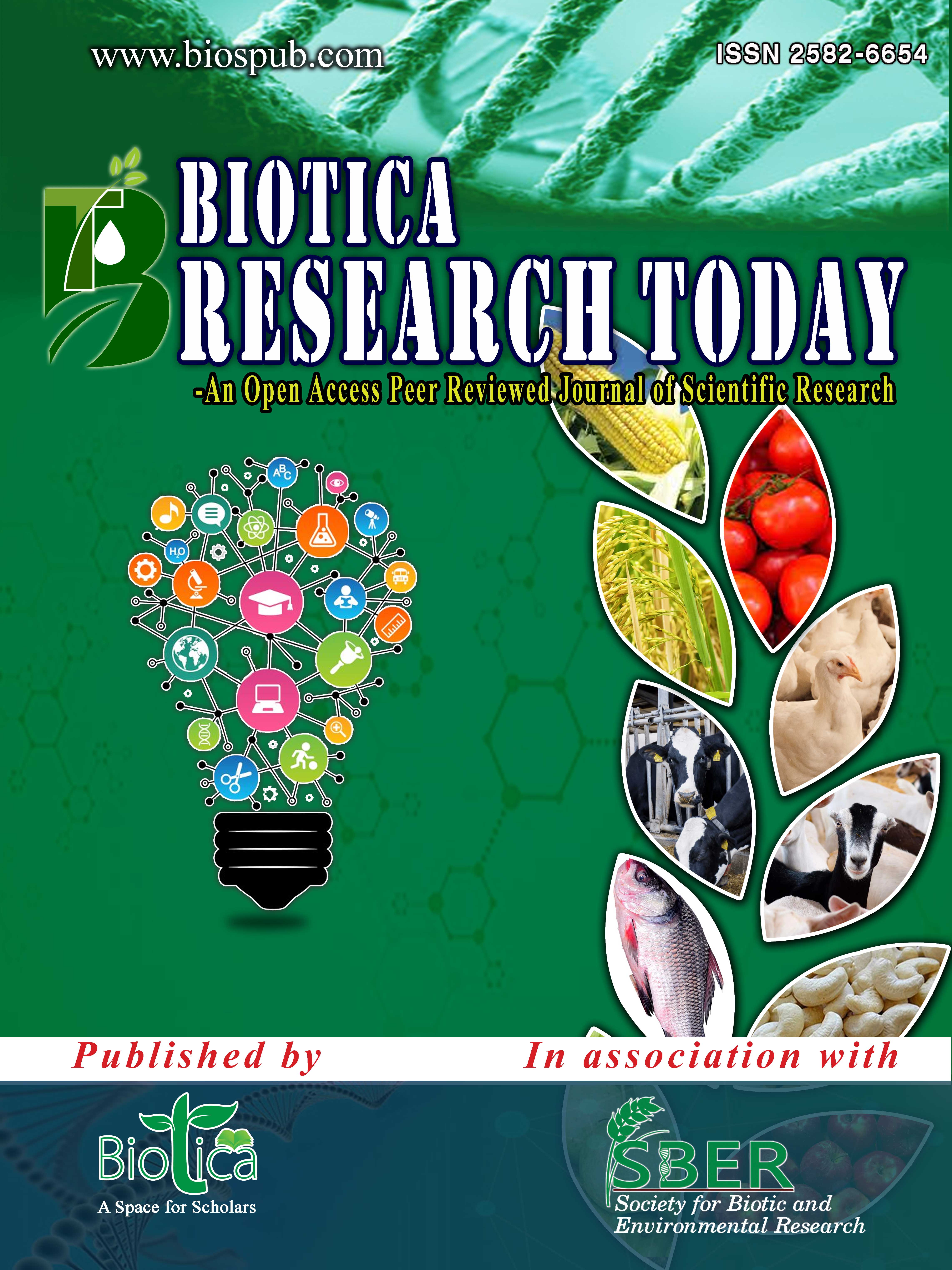Seasonal Incidence of Different Insect Pests and Their Natural Enemies in Tomato Ecosystem
DOI:
https://doi.org/10.54083/ResBio/5.3.2023/122-131Keywords:
Aphis gossypii, Helicoverpa armigera, Liriomyza trifolii, Natural enemies, Seasonal incidenceAbstract
A field investigation was carried out to analyze the seasonal incidence of different insect pests and their natural enemies in tomato ecosystem along with their correlation with weather parameters from December, 2020 to April, 2021. A total number of 10 insect pests and 11 natural enemies were documented throughout the season. Among those insect pests recorded, tomato fruit borer, Helicoverpa armigera was the major one (49.91% relative abundance) followed by aphid, Aphis gossypii (18.62%), serpentine leaf miner, Liriomyza trifolii (16.20%) and whitefly, Bemisia tabaci (7.33%). Among the natural enemies, coccinellids were found abundantly and Coccinella transversalis recorded the highest relative abundance of 26.77% followed by Cheilomenes propinqua (10.23%), Cheilomenes sexmaculata (10.23%) and Coccinella septempunctata (9.44%). The findings of the experiment indicated that the maximum population of Helicoverpa armigera and L. trifolii was observed on the 10th SMW. While in case of A. gossypii it was observed on the 7th SMW respectively. The correlation between insect infestations and meteorological conditions demonstrated that the min temp. showed notable positive correlation with H. armigera and Aphis gossypii population and considerable negative correlation with L. trifolii. The max temp. showed noteworthy negative correlation with L. trifolii and Aphis gossypii. The morning relative humidity was found to possess significant positive correlation with L. trifolii and negative correlation with H. armigera. The evening relative humidity showed negative correlation with L. trifolii and Aphis gossypii. The study's findings provide a clear picture of the level of harm caused by insect pests in addition to helping us anticipate the seasonal occurrence of these pests for the purposes of pest monitoring and management.
Downloads
References
Aheer, G.M., Muhammad, L., Muhammad, S., 1998. Quantitative losses of tomato fruits caused by tomato fruit borer, Heliothis armigera (Hub.). Pakistan Journal of Entomology 20(1-2), 87-88.
Anonymous, 2021. APEDA Agri Exchange Portal. Available at http://agriexchange.apeda.gov.in. Accessed on: December 19, 2022.
Anonymous, 2022. NHB. National Horticulture Database, 2021-22 (1st Advance Estimates). Available at: https://nhb.gov.in. Accessed on: December 19, 2022.
Canene-Adams, K., Campbell, J.K., Zaripheh, S., Jeffery, E.H., Erdman, J.W. Jr., 2005. The tomato as a functional food. The Journal of Nutrition 135(5), 1226-1230. DOI: https://doi.org/10.1093/jn/135.5.1226. DOI: https://doi.org/10.1093/jn/135.5.1226
Chakraborty, K., 2011. Incidence and abundance of tomato leaf miner, Liriomyza trifolii (Burgess) in relation to the climatic conditions of Alipurduar, Jalpaigur, West Bengal, India. Asian Journal of Experimental Biological Sciences 2(3), 467-473.
Chaudhuri, N., Senapati, S.K., 2001. Evaluation of pesticides from different origin-synthetic and biological, against pest complex of tomato under Terai region of West Bengal. Haryana Journal of Horticultural Sciences 30(3), 274-277.
Chaudhuri, N., Deb, D.C., Senapati, S.K., 2001. Assessment of loss in yield caused by pest complex of tomato under terai region of West Bengal. Research on Crop 2(1), 71-79.
Choudary, D.P.R., Rosaiah, B., 2000. Seasonal occurrence of Liriomyza trifolii (Burgess) (Agromyzidae: Diptera) on tomato crop and its relation with weather parameters. Pest Management and Economic Zoology 8(1), 91-95.
Dhandapani, N., Shelkar, U.R., Murugan, M., 2003. Bio-intensive pest management (BIPM) in major vegetable crops: An Indian perspective. Journal of Food Agriculture and Environment 1(2), 333-339.
Galande, S.M., Ghorpade, S.A., 2010. Population dynamics of serpentine leaf miner (Liriomyza trifolii Burgess) on tomato and its relation with meteorological parameters. Journal of the Maharashtra Agricultural Universities 35(1), 89-92.
Gebhardt, S.E., Thomas, R.G., 2002. Nutritive Value of Foods. United States Department of Agriculture, Agricultural Research Service: Home and Garden Bulletin, MD, USA. p. 95.
Harshita, A.P., Saikia, D.K., Deeve, A., Bora, L.C., Phukan, S.N., 2018. Seasonal incidence of fruit borer, Helicoverpa armigera and its eco-friendly management in tomato, Solanum lycopersicum. International Journal of Chemical Studies 6(5), 1482-1485.
Kachave, D.R., Sonkamble, M.M., Patil, S.K., 2020. Population dynamics of major insect pests infesting to tomato, Lycopersicon esculentum (Miller). Journal of Pharmacognosy and Phytochemistry 9(3), 344-348.
Kakati, M., Saikia, D.K., Nath, R.K., 2005. Seasonal history and population build up of tomato fruit borer, Heliothis armigera (Hb.). Research on Crop 6(2), 371-373.
Kaur, S., Kaur, S., Srinivasan, R., Cheema, D.S., Lal, T., Ghai, T.R., Chadha, M.L., 2010. Monitoring of major pests on cucumber, sweet potato, sweet pepper and tomato under net-house conditions in Punjab, India. Pest Management in Horticultural Ecosystems 16(2), 148-155.
Kaushik, P., Meena, R.S., Barman, M., Layek, A., Debnath, P., 2023. Relative abundance and effect of weather parameters on the prevalence of major insect pests complex of tomato in the eastern region of Uttar Pradesh. Journal of Entomological Research 47(1), 88-93. DOI: https://doi.org/10.5958/0974-4576.2023.00015.4. DOI: https://doi.org/10.5958/0974-4576.2023.00015.4
Kharpuse, Y.K., Bajpai, R., 2006. Seasonal incidence of major insect pests of tomato (Lycopersicon esculentum Mill). Indian Journal of Tropical Biodiversity 14(2), 178-181.
Kuldeep, S., 2013. Seasonal abundance of fruit borer, Helicoverpa armigera and its impact on marketable fruit production in tomato, Lycopersicon esculentum (Mill.). Agricultural Science Digest 33(4), 247-252. DOI: https://doi.org/10.5958/j.0976-0547.33.4.019. DOI: https://doi.org/10.5958/j.0976-0547.33.4.019
Luthria, D.L., Sudarsan, M., Krizek, D.T., 2006. Content of total phenolics and phenolic acids in tomato (Lycopersicon esculentum Mill.) fruits as influenced by cultivar and solar UV radiation. Subtropical Plant Science 19(8), 771-777. DOI: https://doi.org/10.1016/j.jfca.2006.04.005. DOI: https://doi.org/10.1016/j.jfca.2006.04.005
Muhammad, S., Waseem, A., Ameer, H., Waqar, A.M., Arif, A., 2014. Population dynamics of Aphid (Aphis Gossypii G.) on tomato agro-ecosystem in Faisalabad region. International Journal of Research in Agricultural Science 1(3), 182-185.
Nitin, K.S., Shridhar, V., Kumar, K.P., Chakravarthy, A.K., 2017. Seasonal incidence of South American tomato moth, Tuta absoluta (Meyrick) (Gelechidae: Lepidoptera) on tomato ecosystem. International Journal of Pure and Applied Biosciences 5(1), 521-525. DOI: https://doi.org/10.18782/2320-7051.2576. DOI: https://doi.org/10.18782/2320-7051.2576
Pandey, B.M., Tripathi, M.K., Lakshmi, V., 2012. Seasonal incidence of gram pod borer, Helicoverpa armigera (Hub.) on chickpea in Varanasi area. Journal of Experimental Zoology, India 15(2), 667-669.
Ravipati, N.S.N., Shukla, A., Sahu, B., 2020. Influence of weather parameters on the incidence of serpentine leaf miner, Liriomyza trifolii (Burgess) on tomato. International Journal of Current Microbiology and Applied Sciences 9(5), 2260-2265. DOI: https://doi.org/10.20546/ijcmas.2020.905.257. DOI: https://doi.org/10.20546/ijcmas.2020.905.257
Reddy, N.A., Kumar, C.T.A., 2005. Influence of weather factors on abundance and management of serpentine leaf minor, Liriomyza trifolii (Burgess) on tomato. Annals of Plant Protection Sciences 13(2), 315-318.
Reddy, N.A., Kumar, C.T.A., 2004. A study on correlation between abiotic factors and incidence of tomato fruit borer, Helicoverpa armigera (Hubner). Mysore Journal of Agricultural Sciences 38(3), 417-421.
Reddy, V., Ananadhi, P., Elamanthi, S., Varma, S., 2009. Seasonal occurrence of pulse pod borer Helicoverpa armigera on chickpea at Eastern U.P. Region. Agricultural Science Digest 29(2), 60-62.
Rishikesh, M., Rajesh, P., Sunil, S.P., 2015. Seasonal incidence of insect complex on tomato (Solanum lycopersicon L.). Journal of Entomological Research 39(4), 347-352. DOI: https://doi.org/10.5958/0974-4576.2015.00044.4
Sajjad, M., Ashfaq, M., Suhail, A., Akhtar, S., 2011. Screening of tomato genotypes for resistance to tomato fruit borer (Helicoverpa armigera hubner) in Pakistan. Pakistan Journal of Agricultural Research 48(1), 49-52.
Salam, R., Devi, H.S., Singh, Y.S., Imtinaro, L., Devi, H.M., 2023. Incidence of major insect pests of tomato influenced by environmental factors in western Manipur. International Journal of Innovative Horticulture 12(1), 109-113. DOI: https://doi.org/10.5958/2582-2527.2023.00012.X
Singh, S., 2017. Studies on insect pests of tomato with special reference to seasonal incidence and management of serpentine leaf miner Liriomyza trifolii Burgess. M.Sc. (Ag.) Thesis, Indira Gandhi Krishi Vishwavidyalaya, Raipur (Chhattisgarh).
Umeh, V.C., Kuku, F.O., Nawanguma, E.I., Adebayo, O.S., Manga, A.A., 2002. A survey of the insect pests and farmers’ practices in the cropping of tomato in Nigeria. TROPICULTURA 20(4), 181-186.
Variya, M.V., Patel, J.J., 2013. Population dynamics of leaf miner (Liriomyza trifolii Bugress) on tomato in relation to weather parameters. AGRES - An International e-Journal 2(3), 385-391.
Wade, P.S., Wankhede, S.M., Hatwar, N.K., Shinde, B.D., Sanap, P.B., 2020. Seasonal incidence of major pests infesting tomato (Solanum lycopersicum L.). Journal of Entomology and Zoology Studies 8(3), 1546-1548.
Waluniba, Ao, M.A., 2014. Seasonal incidence of insect-pests in tomato (Lycopersicon esculantum M.) on different planting dates and its correlation with abiotic factors. International Journal of Bio-Resource and Stress Management 5(2), 280-284. DOI: https://doi.org/10.5958/0976-4038.2014.00568.5
Downloads
Published
How to Cite
Issue
Section
License
Copyright (c) 2023 Research Biotica

This work is licensed under a Creative Commons Attribution-NonCommercial-NoDerivatives 4.0 International License.
Submission of a manuscript implies that when the manuscript is accepted for publication, the authors agree to automatic transfer of the copyright to the publisher (or grant the Publisher exclusive publication and dissemination rights). The Biotica, as the publisher, has the right to enter into any agreement with any organization in India or abroad engaged in reprography, photocopying, storage and dissemination of information contained in this journal. The Biotica has no objection in using the material, provided the information is being utilized for academic purpose but not for commercial use. Due credit line should be given to Biotica where information will be utilized.









 |
|


